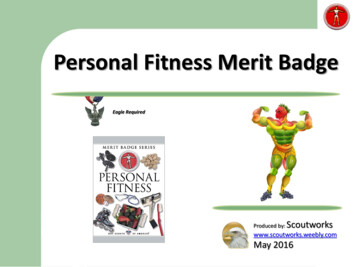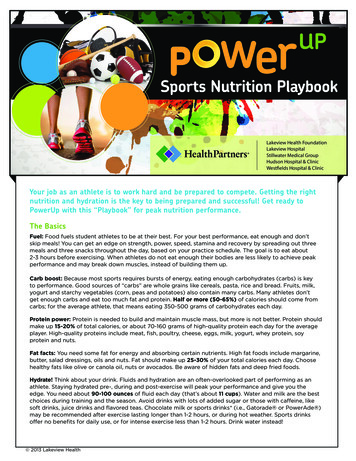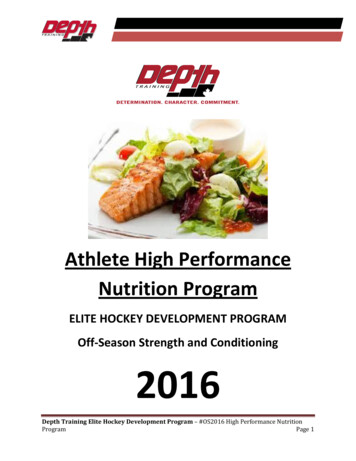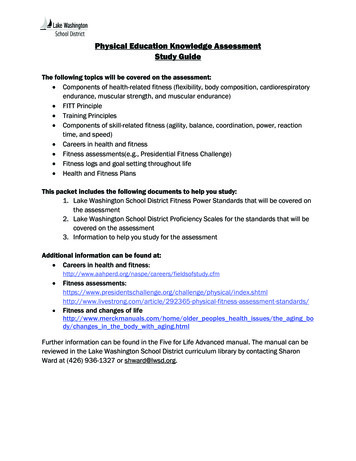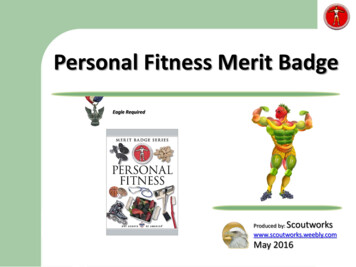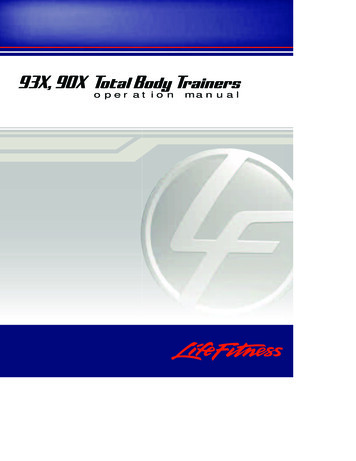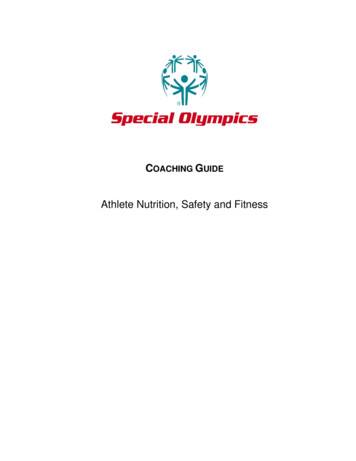
Transcription
COACHING GUIDEAthlete Nutrition, Safety and Fitness
Athlete Nutrition, Safety and FitnessTable of ContentsTable of ContentsNutritionHydration - Keeping Water in the BodyCaloriesEnergy BalanceNutrient BalanceTypes of NutrientsBalanced DietPre-Competition Meal/NutrientsDuring Competition NutrientsPost-Competition NutrientsAnalyze Your DietFitnessSample Fitness ProgramFitness TrianglesThings to Keep Athletes Tobacco FreePrinciples of TrainingLaw of OverloadLaw of ReversibilityLaw of SpecificityPrinciple of IndividualismPrinciple of VarietyPrinciple of Active InvolvementTraining Principles SummaryTraining PeriodsSystems TrainingEnergy SystemsAerobic System (with oxygen)Anaerobic Lactic System (without oxygen)Muscular System2Special Olympics Coaching Guide – General SectionsCreated: December 2003
Athlete Nutrition, Safety and FitnessTable of ContentsStrength Training and ConditioningStrengthPrinciples of Strength Training and Conditioning at-a-GlanceMuscle-Specific Strength ExercisesExercises to Develop Back and Abdomen MusclesExercises to Develop Arm and Shoulder MusclesExercises to Develop Foot and Leg MusclesExercises for Agility and ConditioningPlyometrics TrainingCoaches Guidelines for Teaching PlyometricsPlyometric DrillsDesigning a Strength and Conditioning CircuitCircuit TrainingTraining ConsiderationsSetting up the CircuitSample Training Circuit RoutinesGeneral Conditioning Circuit – Sample 1General Conditioning Circuit – Sample 2Special Olympics Coaching Guide – General SectionsCreated: December 20033
Athlete Nutrition, Safety and FitnessNutritionNutritionIn this section, we will see how the food we eat impacts successful training and competition. Nutrition basically meansall the food we eat and the beverages we consume. Food is our body’s energy source which gives us our “get up andgo.” Without it, athletic performance goes down.Hydration - Keeping Water in the BodyDuring exercise, the body loses water primarily through sweat, even in cold weather or in water. The body has severalmechanisms to protect itself from the negative effects of dehydration, but thirst does not occur until the person isalready dehydrated! As small a loss as 4 percent of body weight (4 pounds in a 100 pound person) can seriously affectperformance.The goal is to keep the athlete hydrated and not allow him/her to become dehydrated. The easiest way is to create asimple, routine system that all your athletes follow:When to Drink WaterHow Much Water to DrinkNight before practice or competitionGlass of water (8 oz/250ml)Four hours before eventGlass of water (8 oz/250ml.)15 minutes before eventOne-half glass of water (4 oz/125ml)During event of less than one hourOne water breakDuring event of more than one hourOne-half glass every 20 minutesAfter eventGlass of water every three hours until next dayAthletes need to be instructed to “drink as much water as they want.” Several serious medical conditions can occurfrom too much water. If you are practicing in warm environments, you may need to increase the frequency of waterbreaks. The athlete can hydrate with several types of liquids; however, the best replacement for most events is plainwater.WaterCarbohydrate drinks (PowerAde, Gatorade)Mixture of one-third fruit juice and two-thirds water is best used when the activity is of longer duration thanone hourCaloriesThe energy the body gets is measured in calories. Different foods provide different amounts of energy, thereforevarying amounts of calories. The amount of calories a person needs depends on many factors. Our metabolic rate is thespeed at which we convert food to energy. This rate can be fast, slow or moderate, depending on the athlete. Forexample, younger athletes require about 3,000 calories per day. This may decrease for some older athletes that have lessstringent training and competition programs. All these factors determine an athlete’s diet. If insufficient calories are notconsumed, an athlete’s performance will be negatively impacted.4Special Olympics Coaching Guide – General SectionsCreated: December 2003
Athlete Nutrition, Safety and FitnessNutritionEnergy BalanceEnergy balance is important for successful training and competition.Energy Intake Energy OutputEnergy Intake Energy OutputEnergy Intake Energy OutputNutrient BalanceNutrients have different jobs, though they work together or need the presence of others to work properly. Nutrientbalance is like the energy balance. Athletes must take in all the nutrients they require to be healthy and strong intraining and competition. A typical high performance diet for an athlete will provide most energy from carbohydrates,with low and almost equal amounts of fat and protein.Recommended High Performance DietProteins, 20%Carbohydrates,60%Fats, 20%Types of NutrientsProtein—main body building nutrientConstant need for regular intakeHigh quality: eggs, milk, fish, meatLow quality: nuts, lentils, beansToo much protein converts into energy source or stored as body fatSpecial Olympics Coaching Guide – General SectionsCreated: December 20035
Athlete Nutrition, Safety and FitnessNutritionCarbohydrates—our energy foodBody’s major energy sourceBreaks down quickly and easily in digestive systemGood sources (complex): rice, corn, potatoes, beans, fruitsPoor sources: white sugar, honey, soft drinks, chocolate barsComplex carbohydrates need to be main part of dietFats—slow energy foodConcentrated energy source, twice as much as carbohydratesBreaks down very slowly and uses more oxygen to create energyNeed small amounts for optimal healthVisible fats: butter, margarine, plant and fish oils, fat on meatInvisible fats: milk, cheese, nuts, certain vegetables (vegetable fat is better for us)Vitamins—most easily consumed through well-balanced dietNeed small amounts dailyLow levels can reduce performanceHighest proportions in natural, fresh foodsFat soluble: stored in body and ready for useWater soluble: cannot be stored, must be in daily food intakeVitamin C cannot be used without ironMinerals—most easily consumed through well-balanced dietNeed small amounts dailyEssentials: calcium, sodium, potassium, iron, iodineIron is essential for oxygen transport throughout the bodyIron cannot be used without Vitamin CIodine controls rate that energy is releasedCalcium helps muscles react normally and recover from exercise6Special Olympics Coaching Guide – General SectionsCreated: December 2003
Athlete Nutrition, Safety and FitnessNutritionWater—required by the body for survivalPerformance is impacted immediately if water needs are not met, especially for aquatics athletesThe harder you train and exercise, the more water you needDrink water often and in small amounts before, during and after competitionFood contains more water than we rcentage of WaterPercentage of Water Found in FoodsType of FoodsFiber—important though often ignoredNot absorbed by bodyHigh fibers: natural plant foodsGood fibers (bran): wheat, oats, brown riceLow fibers (processed foods): white flour, white sugar, white rice, white pastasMake you feel full without getting fatSpecial Olympics Coaching Guide – General SectionsCreated: December 20037
Athlete Nutrition, Safety and FitnessNutritionBalanced DietA balanced diet maintains proper energy and nutrient balance. It does not have to be expensive when you follow someof the ideas below.Guidelines for a Balanced DietEats lots of different kinds of food – vegetables, fruits, fish, meats, dairy produce and grainsEat fresh food rather than ready prepared, canned or frozen foodsEat a high proportion of complex carbohydrate rich foodsGrill, steam or bake foods. Avoid boiling or fryingAvoid fatty meals and sweet and salty snacksCheck fiber intake by eating whole grain breads, cereals, pastasEat brown rice instead of white riceFlavor food with herbs and spices rather than saltDrink small amounts of water and fruit juices oftenPre-Competition Meal/NutrientsThe body’s energy levels need to be high before training and competition. The high performance diet above will supplythis everyday requirement. Athletes are individuals and require different foods and their body responds differently tocertain foods. Generally speaking, the guidelines below will help your athletes consume the proper nutrients beforecompetition.Eat a small, easily digestible meal, usually less than 500 caloriesEat about 2½-4 hours before competingLimit proteins and fats since they digest slowlyAvoid foods which form gas in digestive systemDrink small amounts of water often, before, during and after competingDuring Competition NutrientsBesides hydration, nutrients are not needed for events that last less than one hour.For events that have more than one hour of continuous activity, carbohydrate drinks or fruit will supply theneeded energy for continued effort.During tournaments lasting more than two hours, let your athletes nibble on small pieces of banana, peanutbutter sandwiches, noodles or plain pasta (complex carbohydrates) when they have at least a half-hour breakbefore their next game. This will help them keep their energy levels up. Do not fast your athletes for theduration of a 6-8 hour event.8Special Olympics Coaching Guide – General SectionsCreated: December 2003
Athlete Nutrition, Safety and FitnessNutritionPost-Competition NutrientsTo replenish energy, foods with readily available carbohydrates (fruit, carbohydrate drink, granola bars) shouldbe eaten in small amounts immediately following exercise.Throughout the remainder of the day, meals should contain 65 percent complex carbohydrates to replenishenergy.Special Olympics Coaching Guide – General SectionsCreated: December 20039
Athlete Nutrition, Safety and FitnessNutritionAnalyze Your DietThe following questions will help you analyze your athlete’s diet (and yours). Mark the column with the most accuratereply.QuestionYesNoDo Not KnowAre there a lot of different foods in your diet?Do you eat enough carbohydrates?Do you eat mostly complex carbohydrates?Do you eat animal proteins?If yes, are they mostly red meat?Mostly fish and white meat?Do you eat eggs?Do you eat dairy produce?Do you eat a variety of plant proteins?Are there a lot of vegetable fats in your diet?Is your food mostly fresh?Is your food mostly canned?Do you drink a liter, or more of water a day?Do you drink mostly soft drinks?Is there enough fiber in your diet?How do you prepare your food mostly?SteamedGrilledBakedStir FriedBoiledFriedRecommendationsFoods to AddFoods to DecreaseChanges in StorageChanges in Cooking10Special Olympics Coaching Guide – General SectionsCreated: December 2003
Athlete Nutrition, Safety and FitnessFitnessFitnessFitness is how well a person is adapted to and capable of living a certain lifestyle. The fitness requirement of ourathletes is greater than that of non athletes. Training theory brings together all the information about sport from socialand scientific sources. The coach and athlete work together to produce an effective training program to increase anathlete’s fitness and ultimately improve their athletic performance.Fitness is made up of five basic lityCoordinationEach exercise in training develops a specific component. Different events have different demands on ceDuration and distance maximalSpeedQuickness and frequencyFlexibilityAgility and conditioningCoordinationComplex movementsSpecial Olympics Coaching Guide – General SectionsCreated: December 200311
Athlete Nutrition, Safety and FitnessFitnessSample Fitness ProgramFocus on overall general fitness for Special Olympics athletes. The program below has three major components—warm-up, exercises and cool-down. The number of reps and sets will determine the goal of your program: muscleendurance or muscle strength. Review the following muscle specific strength exercises and plyometric drills to developyour own fitness program.ActivityDurationWarm-UpAn Athletics ExampleEasy aerobic walk/jog/run3-5 minStretching15-20 minUpper Body3-5 exercisesLow Back-Glutesof eachLower Bodymuscle groupExercisesAgility & ConditioningAcceleration Strides3 x 30mLeg Swings (F/S)1 x 10 each legCalf Raises1 x 10 each legArms & ShouldersPush ups: Wide5 repsTriceps Dip5 repsPush ups: Regular5 repsBack & AbdomenSit Ups: Side Lifts10 repsLeg Raises10 repsTrunk Twists10 repsFoot & LegsLunges – Walking3 x 30mSquats10 repsKangaroo Hops2x5Cool-DownEasy aerobic walk/jog/run3-5 minLight Stretching10-15 minA strength training and conditioning circuit can be used in the exercise section above within your fitness program.12Special Olympics Coaching Guide – General SectionsCreated: December 2003
Athlete Nutrition, Safety and FitnessFitnessFitness TrianglesFitness triangles are an excellent way to attain good fitness. A fitness triangle exercise cane easily be integrated into astrength and/or conditioning circuit. Maintaining proper running form and building muscular strength is the purpose ofthe fitness triangle below. Repeat this triangle several times after a long warm-up. A good warm-up would start with a1-1½ mile jog and ample stretching. Running or jogging to a park is a good break from the track.Fitness Triangle - Example 120 crunchesSprintSprintStart10 push upsSprint10, 1-LeggedSquats, each legFitness Triangle - Example 2Special Olympics Coaching Guide – General SectionsCreated: December 200313
Athlete Nutrition, Safety and FitnessFitnessThings to Keep Athletes Tobacco-FreeTop physical conditioning is not accidental. It is the result of lots of hard work and proper guidance that promotespositive athlete behavior. As a coach, you have tremendous influence on an athlete’s nutrition, physical conditioning,sportsmanship, personal responsibility and goal setting. The effects of tobacco use are extremely limiting to athleticperformance, especially when athletes are recovering from injuries. The following are a few things to help keep yourathletes and their sporting environment – tobacco free.1. Never use tobacco products around your athletes. Recognize the influence you have over them. Model thebehavior you would like them to assume.2. Adopt a tobacco-free policy for you and your players.3. Share your tobacco-free policies with athlete’s family members and caregivers.4. Distribute tobacco-free information to your athletes.5. Work with assistant coaches and athlete family members to make the field of play tobacco-free.6. Connect with a community group that is also working for a tobacco-free community.7. Talk to you athletes about the health effects of tobacco. Remember they will relate more to messages about theimmediate effects of tobacco use – such as poor athletic performance – than to it long term health effects. Makethe following points over and over.Tobacco cuts down on fitness. So if you smoke or use other tobacco products, you are not going to be ableto run as fast or as far as your tobacco-free teammates and competitors.There are no safe tobacco products. Spit tobacco and cigars also cause cancer and harm your athleticperformance.Tobacco slows down your lung growth and reduces lung function. That can leave you gulping for air whenyou need it most.Teen smokers suffer from shortness of breath almost three times as often as teens who do not smoke. Breathis something and athlete cannot afford to be short of!A smoker’s heartbeat is three times faster than that of a non smoker. So in competition, your body wastes alot of heartbeats just trying to keep up with non smokers.Young smokers produce phlegm (yuck!) more than twice as often as those who do not smoke. Ever trybreathing and trying to spit at the same time?Three out of four young people who smoke say they keep smoking because it is really hard to quit. Do youwant to be hooked on nicotine or sports?Teens who smoke are more likely to drink heavily and use illegal drugs such as marijuana and cocaine. So,if you think, “it is just cigarettes,” think again.The long term health effects of smoking may seem to be in the distant future, but they are real. Each year,smoking kills more people than AIDS, alcohol, drug abuse, car crashes, murders, suicide and fires –combined! Smoking and athletic performance definitely do not mix.8. Spread the word about tobacco on athletes and their bodies and athletic performance.14Special Olympics Coaching Guide – General SectionsCreated: December 2003
Athlete Nutrition, Safety and FitnessPrinciples of TrainingPrinciples of TrainingTraining is a systematic process in which athletes improve their fitness to meet the demands of their sport. Training is along-term process that is progressive and meets the individual athlete at their level of fitness and conditioning. Traininguses both general and event-specific exercises to develop an athlete for their sport. Training is a cyclical process: teardown, recovery, super-compensation and buildup (adaptation).When we train, we do specific damage to some cells, and use up cellular resources (fuel, water, salts). When youwalk off the track or get out of the pool after a workout, you are weaker, not stronger. How much weaker depends onthe amount and intensity of the exercise. After the training session, if the body is given proper rest and food, the bodywill adjust to super-compensate and prepare for the next stress.Law of OverloadOverloading is perhaps the fundamental principle of fitness. It is basically an increase in demand to force bodilyadaptation. A training load is the work or exercise that an athlete performs in a training session. Loading is the processof applying training loads—training verloadingWhen an athlete’s fitness is challenged by a new training load there is a response from the body. This bodilyresponse is called an adaptation. The initial response is fatigue. When the loading stops there is a process of recovery.Recovery and adaptation take the athlete to a higher level of fitness from where he/she started.It is safest to alter one of the three factors below to overload the body. We will address these three factors eventspecifically in each sport specific coaching guide. The load is changed in a slow, systematic manner to allow gradualadaptation of the body.Frequencyhow oftenDurationhow longIntensityhow hardThe body’s ability to adapt explains how training works. If the training load is not great enough there is little or noincrease in fitness level or athletic performance. A loading that is too great can result in injury or illness to the athlete.Law of ReversibilityYou know the saying, “If you do not use it, you lose it.” If athletes are not training regularly, there is no need for theirbodies to adapt. Be creative and innovative in getting your athletes to train and compete more often. Increased trainingfrequency will not only help them improve their athletic performances, but their fitness levels will improve as a directresult of increased training. That will have a positive impact on their overall quality of life—they’ll be healthier.It is also important to not over train or overload the body so much that it experiences incomplete adaptation. Rest isno longer adequate for recovery. Decline in performance caused by incomplete adaptation is one of the most obvioussigns of over training.Additional common signs of over training include the following.Irritability and moodinessSpecial Olympics Coaching Guide – General SectionsCreated: December 200315
Athlete Nutrition, Safety and FitnessPrinciples of TrainingAltered sleep patternsLoss of appetiteLoss of motivation or competitive drivePersistent muscle soreness that does not go awayFatigue not relieved by restIncreased incidence of minor illness or injuryLaw of SpecificityThe specific nature of a training load produces its own specific response and adaptations. The exercise will have a veryspecific pattern of joint and muscle coordination. The training load must be specific to both the individual athlete andthe demands of their chosen event. This does not negate general training. General training prepares athletes for specifictraining. The greater the volume of general training, the greater the capacity is for specific training.Principle of IndividualismAthletes respond in their own individual way to fitness activities. Athletes bring their unique talents, capabilities,capacities and responses to training. Heredity determines many physiological factors such as heart and lung size,characteristics of muscle fiber, physique and balance. The amount of rest and sleep as well as responses to theenvironment (heat/cold, pollution, stress and altitude) vary from one athlete to another. Nutrition and past or currentillness or injury will also have an influence on ability to perform.The body’s physiological readiness for training is another important factor. Athletes at the same chronological agecan be at very different levels of maturity, and up to four years apart in their developmental and biological ages. Inaddition, training age, the length of time an athlete has been training, must also be considered.Athletes – Same Chronological Age – Different Training CapacitiesChronological AgeBiological AgeTraining Age119111133Athletes – Same Chronological Age – Similar Training CapacitiesChronological AgeBiological AgeTraining Age1213215132Principle of VarietyTraining is a long-term process and loading and recovery can become boring. Plan variety into your athlete’s trainingprogram. Build in cross-training workouts and add pool workouts to the program. Be creative. Variation is analternation of stress and is a necessary part of an athlete’s progression. A weekly and monthly schedule should containalternating periods of hard and easy work. Work should alternate with periods of rest to allow the body to adapt to thechanges that have occurred.16Special Olympics Coaching Guide – General SectionsCreated: December 2003
Athlete Nutrition, Safety and FitnessPrinciples of TrainingPrinciple of Active InvolvementPerhaps the most important principle, active involvement, requires the athlete wanting to actively and willinglyparticipate in their training program. Improvement in overall fitness requires long-term commitment by the coach andespecially the athlete. This requires that all aspects of an athlete’s life contribute to the success of his/her performanceon the field of play.Training Principles SummaryLaw of OverloadBody adapts to training loads—explains how training worksAdequate training loads improve overall fitness and increase performanceFactors impacting training load—frequency, duration and intensityLaw of ReversibilityTraining loads that increase progressively create higher fitness levelsNo increase in fitness will occur if loading is too far apart or stays the sameOver training or incomplete adaptation occurs when training loads are too great or too closeLaw of SpecificitySpecific training load produces specific response and adaptationsGeneral training prepares athletes for specific trainingGreater the volume of general training, greater the capacity for specific trainingPrinciple of IndividualismAthletes bring their unique talent, capabilities and capacities to trainingHeredity determines many physiological factors that impact trainingChronological, biological and training ages must be considered when designing a training andcompetition planPrinciple of VarietyTraining is a long-term process and loading and recovery can become boringMake it fun for the athleteBe creativePrinciple of Active InvolvementAthlete has to want to actively and willingly participate in their training programAthlete has to be committedAll aspects of an athlete’s life contributes to their athletic successSpecial Olympics Coaching Guide – General SectionsCreated: December 200317
Athlete Nutrition, Safety and FitnessPrinciples of TrainingTraining PeriodsImprovements in performance are not linear but occur at different rates in the physiological systems. For those reasons,fitness and/or sports training should be divided into useful periods with varying goals, depending on the time relation tothe actual athletic event. A well-designed fitness plan not only changes its focus from period to period but also variesfrom hard to easy and from activity to rest within each seasonal period.The most logical division of the year for athletes involved in one or more sporting activities is into periods related tothat sport. If the athlete is involved in more than one athletic event, these periods must be tailored around the severalathletic pursuits.Pre Season (8-12 Week Period Prior to Competition)The goals of the pre-season period include the following:Development of sport-specific muscle strength and enduranceDevelopment of appropriate aerobic (endurance) vs. anaerobic (high-intensity) conditioningDevelopment of muscle power (as needed for activity)Development of sport-specific skills and team playIn Season (Competitive Period)The training program during the actual season has two primary goals:Maintenance of the gains of pre-season trainingContinued specific attention to areas of the body at risk?either from past injury or the particular risks of thesportPost Season (3-4 Week Period or Less Following the End of Competition)Short periodThe goal of this period is rest and physical and mental recovery of the athleteOff Season (Longest Period of Time between Post and Pre Seasons)The focus of the off season is recovery and rehabilitation of injuries; overall aerobic conditioning; development ofgeneral, balanced muscle endurance and strength; and development of neuromuscular balance and coordination.18Special Olympics Coaching Guide – General SectionsCreated: December 2003
Athlete Nutrition, Safety and FitnessSystems TrainingSystems TrainingDifferent exercises use different fuels via different pathways, depending on the intensity and duration of the activity andthe fitness level of the athlete. The goal of effective training is to make the appropriate system most efficient when theactivity is performed. There are two primary systems of the body that have to become fit for activity—the energysystem and the muscular system. This sounds more complicated than it actually is.Sport coaches must understand the energy system capabilities and limitations to design sequenced trainingprograms. In teaching athletes to listen to their bodies during training sessions, adjustments can be furnished in thesequenced workout with careful understanding of the energy system. Remember that all energy systems turn on atbasically the same time; intensive tempo running makes high demands on both the aerobic and anaerobic and, thus, is asharing system.Energy SystemAsk yourself these quick, easy questions to determine which system your exercise is using.1. Is oxygen required? (or, is running or jumping involved)If yes, the energy system is Aerobic?with oxygenIf no, the energy system is Anaerobic—without oxygen2. Is lactic acid produced?If no, the energy system is Anaerobic Alactic (0-10 seconds energy)If yes, the energy system is Anaerobic Lactic (10 seconds-1 minute energy)Athletes are capable of using one or a combination of the two energy systems. Different events demand differenttypes and amounts of muscle activity. Different systems dominate in various events. Our goal is to design a trainingprogram that increases the capacity of a specific energy and muscular system, therefore increasing performance.Aerobic System (with oxygen)Aerobic training is good for the development of the cardiovascular system. It enables athletes to recover from toughworkouts and helps develop the capacity increase repetitions.Very efficient, does not produce fatigue-producing waste productsLower intensity exercisesImportant in the recovery process for all exercisesHeart and lungs are criticalResists fatigueTakes longer to overload than the anaerobic systemsRequires a minimum 20 minutes duration training periodWorkload can be continuous or broken up into interval trainingExamples of aerobic activities include jogging, running, walkingSpecial Olympics Coaching Guide – General SectionsCreated: December 200319
Athlete Nutrition, Safety and FitnessSystems TrainingAnaerobic Lactic System (without oxygen)Less efficient, produces lactic acid, hastening muscle fatigueHigh intensity levelBody must burn carbohydrates stored in muscleLactic acid must be removed?can take up to one hourCarbohydrates must be replaced for further activity to occurFirst ten minutes of active recovery produces greatest reduction in lactic acidProvide majority of energy requiring high bursts of speed or resistance lasting up to 10 secondsBuilt by alternating periods of work and restSeveral easy indications of anaerobic effort are difficulty with breathing, or difficulty with sustaining effortBuilds on the aerobic base, and challenges the athlete at the upper level of aerobic capacityExamples of anaerobic activities include weight training, sprints, starts, jumping, interval training, training atvarious speeds or training at a defined paceMuscular SystemJust as with the energy system, the muscular system must be developed for efficiency of action. The muscular systemcan be trained for endurance, strength, power and speed.Muscle EnduranceMuscular endurance is the ability of the muscle to perform repetitive contractions over a long period of time. Thenumber of repetitions needed is dependent on the particular activity. However, it is important to count minutes ofactivity, not sets. Muscle endurance is increased by adding 1-3 minutes to a workout each week. This training is usuallycompleted in sets and repetitions. Repetition also trains the athlete to perform the activity correctly before anyadditional load is added.Muscle StrengthMuscular strength is the development of maximal force in a musc
Athlete Nutrition, Safety and Fitness Nutrition 10 Analyze Your Diet The following questions will help you analyze your athlete’s diet (and yours). Mark the column with the most accurate reply. Question Yes No Do Not Know Are there a lot of different foods in your diet? Do you eat enoug


